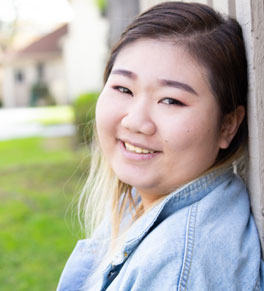ECMO revives young woman’s heart

Complications from lupus and a vicious virus led 22-year-old Tiffany Vu’s heart to collapse, sending her into a coma.
Were it not for the extracorporeal membrane oxygenation (ECMO) device, a portable heart and lung machine that provides critical life support for patients suffering from severe heart and/or lung failure, Vu may not have survived.
“Frankly, she was dying,” says UCI Health cardiothoracic surgeon Dr. Fabio Sagebin, who performed the ECMO procedure in October 2019.
The college student from Garden Grove had never before experienced health problems.
Typical day turns traumatic
It was a typical work day at a local doctor’s office for Vu. Suddenly, her legs began to swell, she couldn’t eat, she was coughing and had stomach pains. Her physician boss and colleagues suggested she go to UCI Medical Center because of the resources and expertise available at Orange County’s only academic medical center.
After many tests and evaluations, Vu was diagnosed with lupus – even though she had no prior symptoms. She vomited blood that evening and ended up staying in the hospital’s intensive care unit (ICU) for a week. Although she was released from ICU, her hospital stay lasted two months.
About a month after she returned home, Vu began experiencing symptoms again, starting with severe diarrhea. She went to the UCI Health emergency department and again ended up in the ICU, where she passed out.
During that second stay, Vu “coded,” or went into cardiac arrest multiple times. To raise her dangerously low blood pressure, she was given adrenaline intravenously.
ECMO: A last resort
“We met with her family,” Sagebin recalls. “We explained that she wouldn’t survive without the ECMO procedure to pump blood and breathe for her. And that she still might not survive even with the procedure. But it was our last resort.”
Vu’s parents and sister Kathy gave their consent for the ECMO procedure.
Immediately, Sagebin and the cardiothoracic team went to work. Within about 30 minutes, the ECMO procedure was completed and the device working at Vu’s bedside.
How ECMO works
Basically, the ECMO machine takes over for the patient’s heart or lungs, allowing them to rest.
The procedure starts with a large tube inserted into the major femoral vein next to the hip.
Blood is pumped from the body into the device’s oxygenator, which removes carbon dioxide and adds oxygen to the patient’s blood. The oxygenated blood is then pumped back into the body through a tube inserted in the legs, neck or chest.
Within a few minutes of being on the ECMO machine, Vu’s blood pressure improved right away, Sagebin says.
Procedure has multiple risks
The ECMO procedure does have multiple risks.
“The first thing we worry about is possible brain or organ damage from not having had enough oxygen reaching the brain before being connected to the ECMO machine — that too much damage had already been done,” Sagebin explains.
Luckily, that wasn’t the case with Vu. “Miraculously, she woke up,” the heart surgeon recalls.
After about a week, she was carefully weaned from the ECMO machine and Sagebin repaired the artery where the device was attached.
Vu spent about six weeks recovering in the hospital, followed by two more weeks of rehabilitation.
“I’m feeling more sturdy than before,” Vu says after a recent checkup. “I can get in and out of the car faster.” She’s also walking unassisted now.
Vu is being treated for lupus, and Sagebin says that says that with good medical control, “she should be able to live a very productive life.”
ECMO requires expertise
As Vu’s experience proves, ECMO can be a life-saving technology for many patients. But because of the tremendous risks that can result from the procedure, having access to skilled cardiothoracic specialists such as the UCI Health team is critical.
“The future of ECMO is expanding,” Sagebin explains. “UCI Health is building an infrastructure to serve the heart needs of the Orange County community.
“We now have a team of surgeons, cardiologists and other interventionists who are passionate about ECMO and its capabilities. We also have a team of full-time intensive-care physicians and perfusionists who staff our dedicated cardiac ICU around the clock. It’s a real team effort.”
Studying to be a dialysis nurse
Vu emerged from her experience grateful – and with a newfound direction.
She already was studying to be a nurse but now looks forward to resuming classes in July to become a dialysis nurse. During her first hospitalization, she was on daily dialysis to remove impurities from her blood, then every other day. The second time she was hospitalized, she was on dialysis 24 hours a day.
“I know what patients have go through,” she explains. “And I loved watching the dialysis nurses work with the machines. It’s just really cool!”
While reflecting on her ECMO experience, Vu recommends the procedure to anyone considering it for themselves or a loved one.
“Go for it,” she says. “Don’t give up. It’s only used when absolutely necessary. And the UCI Health doctors know what is right and when it’s necessary. I wouldn’t be here if they didn’t have it.”
Explore further
Browse more blog posts by topic.




